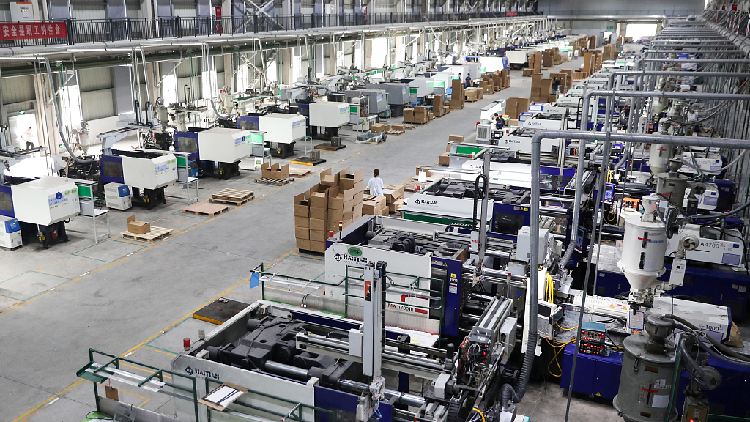
Ma Xiaobai is a research fellow of Development Research Center of the State Council in China. The article reflects the author’s opinion, and not necessarily the views of CGTN.
Since its reform and opening-up in 1978, China has achieved remarkable economic growth and social development. One of the key drivers of this success has been its manufacturing sector, which has transformed China into the world’s largest producer and exporter of manufactured goods. China’s manufacturing sector has also contributed to improving the living standards of hundreds of millions of people, creating a large domestic market, and fostering technological innovation and industrial upgrading.
However, as globalization continues to evolve into the second decade of the 21st century, China’s manufacturing sector is also facing a growing series of challenges: The global economic environment has become more complex and uncertain, with rising trade protectionism, geopolitical tensions, and environmental pressures. The labor costs and other factor costs have risen, eroding China’s traditional competitive advantage of low-cost production. Technological changes have accelerated rapidly, creating new opportunities for innovation, but also new risks and uncertainties. As the demand for higher-quality products has increased, so too has expectations for social responsibility and sustainability.
Will manufacturing, the engine of China’s economic miracle in the past 40 years, continue to power the worlds’ second largest economy in the new coming era?
To cope with these challenges and opportunities, China has proposed the concept of “new industrialization,” which aims to achieve high-quality development of the manufacturing sector in line with the national strategy of building a modern socialist country. New industrialization is not simply a continuation or extension of the old industrialization, but a fundamental transformation and upgrading of the manufacturing sector in terms of its structure, mode, quality, efficiency, and competitiveness.
What’s new with “new industrialization?”
New industrialization means to optimize the structure of the manufacturing sector, by increasing the proportion of high-tech industries, strategic emerging industries, advanced equipment manufacturing industries, and modern service industries, while reducing the proportion of low-end, energy-intensive, and polluting industries. For example, China has been developing its new energy vehicle industry as a strategic emerging industry that can enhance its energy security, environmental protection, and technological innovation.
New industrialization means to upgrade the mode of the manufacturing sector, by promoting digitalization, informatization, intelligentization, networking, and green development, as well as enhancing innovation capabilities, quality standards, brand building, and international cooperation. For example, China has been using artificial intelligence to fuel its industrial revolution by applying it to various fields such as manufacturing, logistics, agriculture, and health care.
New industrialization means to enhance the competitiveness of the manufacturing sector, by fostering core technologies, key components, major equipment, and system integration capabilities that can support independent innovation and national security. For example, China has been developing its own semiconductor industry as a core technology that can support its digital economy and information security.
New industrialization is not only an important goal for China’s economic development but also a significant contribution to the world’s economic recovery and sustainable development. By pursuing new industrialization, China can provide more high-quality products and services to meet the diverse needs of domestic and foreign consumers. China can also share its experience and achievements in industrial transformation and upgrading with other developing countries. China can also participate in global governance and cooperation in areas such as trade rules, standards setting, intellectual property rights protection, climate change mitigation, and environmental protection.
Achieving new industrialization is a systematic project. China needs to adopt a comprehensive and coordinated approach that involves multiple actors and factors.
A synergy between government policy and market energy is essential. The government plays a vital role in creating a business environment that nurtures new industrialization, by formulating clear objectives, indicators, plans, policies, laws, regulations, and standards for the manufacturing sector. The government also supports new industrialization with financial assistance, incentives, and public services. The market, on the other hand, is the main force for allocating resources, stimulating innovation, and enhancing efficiency for new industrialization. The government respects the market rules, protects the market order, and creates a fair market environment for new industrialization.
Innovation-driven development is a key aspect of new industrialization. Enterprises can leverage digital technologies to develop their own core technologies and intellectual property rights, which can enhance their competitiveness and value creation. The government plays a supportive role in fostering innovation by investing in national innovation centers, key laboratories, engineering research centers, and other innovation bases, for new industrialization.
Quality and efficiency are crucial for new industrialization. Digital technologies, including big data, cloud computing, artificial intelligence, Internet of things, and blockchain, will play increasingly vital roles in firms’ quality control and product design. These technologies enable enterprises to collect and analyze data, optimize decisions, automate tasks, connect devices, and secure transactions among many others. Public investments in digital infrastructure, such as broadband, computing center, and Internet of things, offers a more pronounced multiplier effect, yielding higher-quality and better efficiency.
Green development is a vital aspect of new industrialization. Enterprises can adopt green production practices and technologies, such as renewable energy, the circular economy, and clean technology, to reduce their energy consumption, carbon emissions, and environmental pollution. The government plays a regulatory role in promoting green development by setting green standards, certification systems, and supervision mechanisms for the manufacturing sector.
New industrialization also relies on international cooperation. Enterprises could also establish strategic partnerships and alliances with foreign counterparts and stakeholders. The government should support the enterprises to participate in the Belt and Road Initiative, the Regional Comprehensive Economic Partnership, and other international cooperation platforms for new industrialization.
New industrialization is a strategic choice for China to achieve high-quality development of its manufacturing sector and to build a modern socialist country. New industrialization is also a historic opportunity for China to contribute to the world’s economic recovery and sustainable development. New industrialization requires the joint efforts and cooperation of all parties and sectors.
China is confident and capable of achieving new industrialization and creating a new era for its manufacturing sector.






